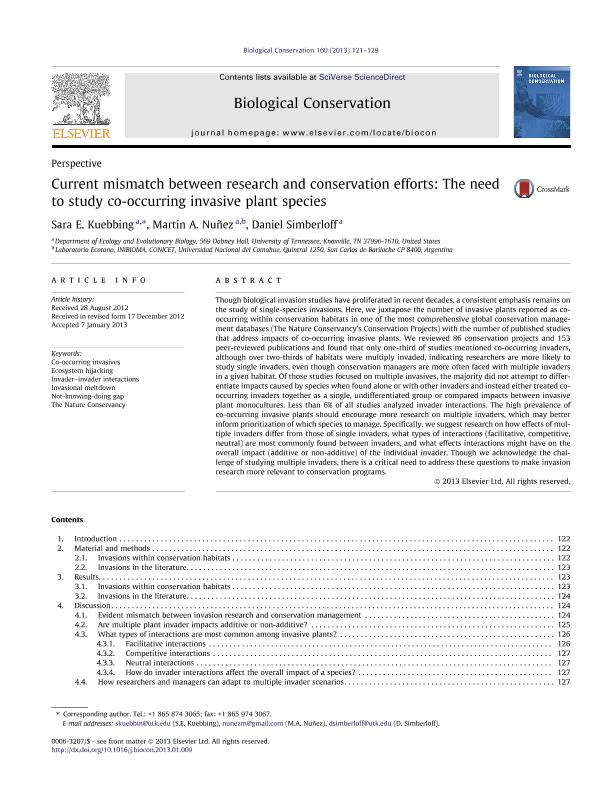Artículo
Current mismatch between research and conservation efforts: The need to study co-occurring invasive plant species
Fecha de publicación:
05/2013
Editorial:
Elsevier
Revista:
Biological Conservation
ISSN:
0006-3207
Idioma:
Inglés
Tipo de recurso:
Artículo publicado
Clasificación temática:
Resumen
Though biological invasion studies have proliferated in recent decades, a consistent emphasis remains on the study of single-species invasions. Here, we juxtapose the number of invasive plants reported as co-occurring within conservation habitats in one of the most comprehensive global conservation management databases (The Nature Conservancy’s Conservation Projects) with the number of published studies that address impacts of co-occurring invasive plants. We reviewed 86 conservation projects and 153 peer-reviewed publications and found that only one-third of studies mentioned co-occurring invaders, although over two-thirds of habitats were multiply invaded, indicating researchers are more likely to study single invaders, even though conservation managers are more often faced with multiple invaders in a given habitat. Of those studies focused on multiple invasives, the majority did not attempt to differentiate impacts caused by species when found alone or with other invaders and instead either treated co-occurring invaders together as a single, undifferentiated group or compared impacts between invasive plant monocultures. Less than 6% of all studies analyzed invader interactions. The high prevalence of co-occurring invasive plants should encourage more research on multiple invaders, which may better inform prioritization of which species to manage. Specifically, we suggest research on how effects of multiple invaders differ from those of single invaders, what types of interactions (facilitative, competitive, neutral) are most commonly found between invaders, and what effects interactions might have on the overall impact (additive or non-additive) of the individual invader. Though we acknowledge the challenge of studying multiple invaders, there is a critical need to address these questions to make invasion research more relevant to conservation programs.
Palabras clave:
N/A
Archivos asociados
Licencia
Identificadores
Colecciones
Articulos(INIBIOMA)
Articulos de INST. DE INVEST.EN BIODIVERSIDAD Y MEDIOAMBIENTE
Articulos de INST. DE INVEST.EN BIODIVERSIDAD Y MEDIOAMBIENTE
Articulos(SEDE CENTRAL)
Articulos de SEDE CENTRAL
Articulos de SEDE CENTRAL
Citación
Kuebbing, Sara E.; Nuñez, Martin Andres; Simberloff, Daniel; Current mismatch between research and conservation efforts: The need to study co-occurring invasive plant species; Elsevier; Biological Conservation; 160; 5-2013; 121-129
Compartir
Altmétricas




